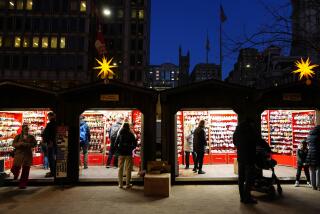Jewelry Sales Tug at Heartstrings--and Purse Strings
- Share via
Surveying a recent crowd of Valentine’s Day customers stooped over display cases filled with diamond rings and jeweled necklaces, a security guard at Tiffany & Co. in Beverly Hills shook his head in disbelief.
“It’s like Christmas all over again,” he said.
For jewelers ranging from upscale Tiffany to mall king Zales Jewelers, it’s been like Christmas for much of the decade, with heavy advertising and promotions by the industry’s biggest players helping push the sector’s sales to successively higher levels.
Valentine’s Day--when about 12% of marriage proposals take place, according to an industry group--is second only to the winter holidays for jewelry sales. So when business is good, February is even stronger.
“Jewelry has been good,” said Todd Slater, an analyst with Lazard Freres & Co. in New York. “The industry is marketing much more strongly to the core demographic more times a year than ever before.”
Like so many other 1998 retail trends, that core demographic--the baby boomers--are a big part of the jewelry industry’s sparkling recent performance.
Consumers in their 40s and 50s have traditionally been the jewelry industry’s best customers, with the most money to burn and the important anniversaries, birthdays and retirements to celebrate with big purchases. What’s more, today’s 35- to 53-year-olds comprise about a third of the U.S. population, so their impact on an industry they favor is huge.
“Each year that the population ages, jewelry expenditures go up,” said Tom Tashjian, a NationsBanc Montgomery Securities analyst in San Francisco.
Other factors have contributed to the increase in jewelry sales: stepped-up advertising, a renewed focus on men’s jewelry and a targeted campaign encouraging women to buy their own jewels.
What’s more, the industry has made an effort to cater to consumers who have grown increasingly value-conscious. Tiffany offers sterling silver heart pendants under $100. And the nation’s largest jeweler in 1997 was Wal-Mart, with more than $1.67 billion in jewelry sales.
“The boomers aren’t out there looking for the newest and hottest fashion,” said analyst Slater. “But there’s something about a diamond that has emotional and intrinsic value that doesn’t exist in a piece of apparel. It’s about romance, it’s about aspiration, it’s about sentimental moments, and jewelry captures all those feelings.”
Tashjian said part of 1998’s jewelry strength can be traced to South African diamond mine giant DeBeers. As Asian and South American demand for jewels sagged right along with the rest of their economies, the diamond industry’s biggest player focused the majority of its recent attention and advertising dollars on the U.S. market.
That advertising helped fuel demand that the bigger retailers were more than willing to serve throughout the year.
Wal-Mart, J.C. Penney Co. and Sears, Roebuck & Co. piggybacked with their own advertising blitzes on major and even minor holidays such as Father’s Day. Mall chains such as Zale Corp.’s Zales Jewelers and Sterling Inc.’s Kay Jewelers blanketed the public with their own fliers hawking diamond bracelets for Christmas and ruby heart pendants for Valentine’s Day.
In 1997, the last year for which sales figures are available, Zale was behind Wal-Mart with more than $1.25 billion in sales and JCPenney came in third, with just more than $1 billion in sales, according to National Jeweler, a trade publication.
At the same time, jewelers fine-tuned their product lines and messages. Tiffany broadened its selection of men’s cuff links and promoted its lower-cost pieces. Tiffany Vice Chairman James E. Quinn said he expected the firm to post 1998 same-store sales increases consistent with the holiday season’s 12% gain over 1997.
And many big stores started advertising directly to a female audience, suggesting that independent women of the 1990s need not wait for men to buy them their baubles, but should purchase fine jewelry for themselves.
But the riches have not been equally divided. While the strong market for platinum, gold, diamonds and the like has burnished the bottom line at many small and large jewelry retailers, independent jewelers have benefited least. Analysts said consumers are drawn to either discounters and mall stores, which offer the best prices, or to top-tier stores such as Tiffany and Cartier, which offer the greatest prestige.
At the moment, independents still control about 67% of the industry, Tashjian estimated. But as soon as five years from now, he said, the independents could be crushed down to the 50% mark; if the economy turns downward, he warned, they could fall to 40% in that same period.
Gus Lejano, a 35-year-old from Cleveland in town on business, emerged onto Via Rodeo last weekend with not one, but two little blue Tiffany bags containing presents worth $1,500 for his wife.
For Valentine’s Day, he bought a silver bracelet to match a necklace he had previously bought for her. For her upcoming 30th birthday, there were diamond earrings.
“It’s something that you keep,” said Lejano, who had planned to spend $500. “It’s more permanent, it’s more special. With jewelry, you can pass it down.”
(BEGIN TEXT OF INFOBOX / INFOGRAPHIC)
Embracing the Holiday
Valentine’s Day might be for lovers, but retailers are the ones glowing with anticipation.
Biggest Valentines’ Day Items
For 1998, in billions
Jewelry: $1.6
Greeting cards: 1.0
Candy: 0.9
Flowers: 0.7
Jewelry Sales
Jewelry sales have grown at a healthy clip for much of the 1990s. Retail sales, in billions:
1987: $12.9 billion
1997: $20.5 billion
Source: National Retail Federation, Commerce Department






